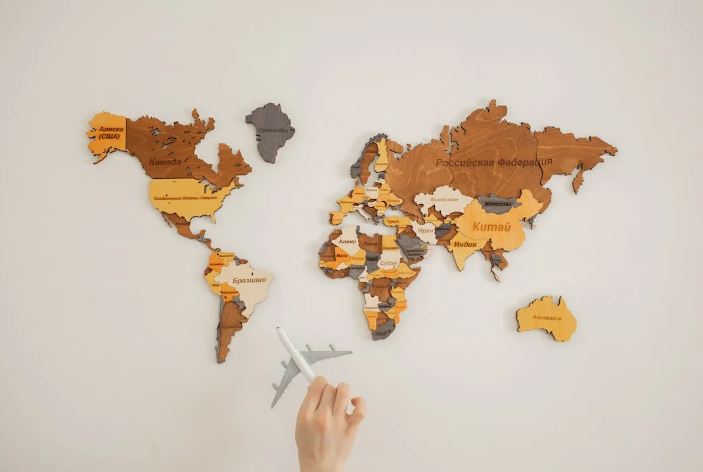Wooden world maps represent a captivating fusion of art and geography, seamlessly blending craftsmanship and cartographic precision. In a world inundated with digital representations, these unique creations provide a tangible and aesthetically pleasing way to explore the diverse landscapes of our planet.
The journey into the fusion of art and geography begins with the careful selection of wood. Artisans choose from a variety of woods, each with its own distinctive grain and color. This selection is not merely functional; it serves as a deliberate artistic choice, shaping the visual character of the final map. Lighter woods like birch may convey a modern, minimalist feel, while darker woods such as mahogany or walnut bring warmth and richness to the piece.
Craftsmanship is at the heart of wooden world maps. Skilled artisans transform flat wooden surfaces into intricate, three-dimensional masterpieces. Every contour, river, and mountain range is meticulously carved or engraved, resulting in a map that is not just a geographic representation but a work of art. The precision of the craftsmanship ensures accuracy while elevating the map beyond a mere informational tool to a visually stunning and thought-provoking creation.
The tactile nature of wooden maps adds an additional layer of charm. Unlike their digital counterparts confined to screens, these creations invite touch and interaction. The natural warmth and texture of the wood create a connection between the viewer and the map, turning the exploration of geography into a sensory experience. Elevation details, carefully carved into the wood, provide a tangible representation of the Earth’s varied topography, making the map not just visually engaging but also physically captivating.
Personalization further enhances the fusion of art and geography in wooden world maps. Many artisans offer customized options, allowing clients to request maps of their favorite places, hometowns, or significant travel destinations. This bespoke approach transforms each map into a unique and meaningful piece, reflecting the personal stories and connections of the owner. The emotional resonance of a map that holds specific memories or landmarks creates a bond that goes beyond its aesthetic appeal.

Wooden world maps find a place not only as standalone artworks but also as versatile elements in interior design. Whether mounted on walls, integrated into furniture, or transformed into functional items like coffee tables or serving trays, these maps seamlessly merge functionality with aesthetics. They become focal points in living spaces, sparking conversations and inviting exploration of the diverse landscapes they portray.
The enduring quality of wood ensures that these maps are not just contemporary novelties but timeless pieces. Unlike digital maps that may become outdated, wooden maps endure, becoming cherished heirlooms passed down through generations. Their longevity adds a layer of significance, capturing not only geographical details but also the enduring craftsmanship and artistry of their creators across time.
In conclusion, wooden world maps epitomize the fusion of art and geography, offering a visually stunning and tactile exploration of our planet. From the careful selection of wood to the meticulous craftsmanship, personalization, and versatility in design, these maps transcend traditional cartography. They invite us to engage with geography on a tangible and personal level, transforming the way we perceive and appreciate the world around us. The fusion of art and geography in wooden world maps is a celebration of craftsmanship, creativity, and the enduring allure of handmade creations.



